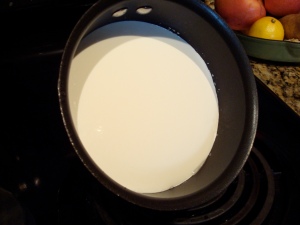Cream Cheese Recipe
Ok, it was my intention to have a variety of different cheese recipes up on this site by now. However, the only ones I have up so far are super easy cheeses that require almost no time or effort. This week’s recipe is another one of these.
Keep in mind, though, that autumn is here. In my neck of the woods, this is the only season that doesn’t make me want stab out my eyeballs. This – coupled with the fact that I am in a much better state of mind since I don’t have a paper to revise, classes to teach, or talks to give – means that I can devote more time to more intensive cheesemaking. What I’m trying to say (in a not-so-eloquent manner) is that in the near future, I have some great recipes lined up. For now, eat some cream cheese.
I will never, ever buy cream cheese again. It is by far the easiest cheese to make in my arsenal. It’s so easy that I debated adding this as a little coda to the chèvre recipe. You’re not going to believe it.
First, you have to buy the starting material. In this case, I prefer to use light cream. It’s not available everywhere, so if you can’t find it you can use half and half. However, half and half is about 12% butterfat and light cream is 20%, so you will sacrifice a little flavor and lusciousness if you opt for the former. Or, if you really wanted to, you could add some heavy whipping cream to half and half. Just remember that your cream must not be ultra pasteurized!
Pour your cream in to a clean container. I like to use a 2 quart saucepan with a lid. To keep things as sterile as can be, I boil water in my saucepan for 5 minutes, pour our the water, and let the pan cool down first.
Add a smidgen of your starter culture (this is 1/64 of a teaspoon). For cream cheese, I like to use a culture that has L. cremoris cremoris, L. cremoris lactis, and L. cremoris diacetylactis. The best part is that you don’t even have to heat anything up! Sprinkle the culture evenly over the surface of the cream and let it hang out for a few minutes.
Next, add one drop of double-strength rennet to 1 tablespoon of bottled water. Gently pour this in to your cream.
Put the lid on your pot and let it hang out at room temperature for 12 hours.
After 12 hours, you will have a solid curd mass. And when I say solid, I mean that you can top the pot on its side and no liquid will come out.
That is all due to lactic acid production and the tiny little drop of rennet that we added. Isn’t that amazing?
While you’re admiring your beautiful curd mass, prep your draining station by boiling some butter muslin for 5 minutes and getting it set in a colander. Scoop your curds in to the prepared muslin.
Tie up the curds and let them hang at room temperature for another 12 hours. After this ripening time, your cheese is ready. Unwrap the cheese and put it in a clean container. Add salt to taste.
From 32 ounces of light cream, I yielded 1.2 pounds (just shy of 20 ounces of cheese!). I like to start this at night, do my curd scooping in the morning, and then finish up the next evening.
It’s fluffier and much more spreadable than the stuff you buy in a box in stores. I highly recommend it.
Cream Cheese
32 ounces of light cream
1/64 tsp. starter culture
1 drop double-strength rennet
1 tbsp. bottled water
- Pour cream in to a sterilized pot.
- Sprinkle starter culture evenly over the surface of the cream.
- Let the culture bloom for 5 minutes, then stir it in.
- Add 1 drop of double-strength rennet to the water and stir well. Slowly trickle the rennet mixture in to the cream and stir for 20 seconds.
- Let the cheese ripen for 12 hours at room temperature.
- Scoop the curds in to sterilized butter muslin.
- Tie up the curd mass in the muslin and let it drain for 12 hours at room temperature.
- After 12 hours, untie the curds and scoop them in to a clean container.
- Add salt to taste, then refrigerate.
Yield: Approximately 1 pound
Use within one week.




